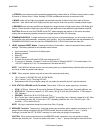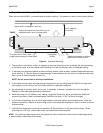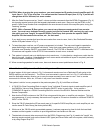
Page 18 Model PA635
© 2001 Xantech Corporation.
TROUBLE SHOOTING
If you encounter a problem, please review the items in the following list. Be sure, in addition, to check other
system components, such as preamplifiers, CD players, speakers, speaker wiring, etc., that may be at fault.
PROBLEM PROBABLE CAUSE AND SOLUTION
Front Panel LEDs and rear panel power indicator does
not light – no sound.
Check line cord for good contact in a live AC outlet. If
the REMOTE MASTER ON/OFF CONTROL terminals
(item #13, Fig. 3) are used, be sure applied voltage is
between +5 V and +30 VDC with proper polarity. Refer
to Fig. 10.
Low level or no sound when operated without IR
control.
Level was previously set by IR to a low level or muted.
Simply press LEVEL (System) RESET button as
instructed in item 9, Fig. 3.
Sound cuts in and out every 3 to 5 seconds. Speaker load impedance is less than 4-Ohms for
Stereo mode or less than 8-Ohms for Bridged mode.
Make changes in matching auto-formers and/or
speakers as necessary to obtain higher impedance.
PA635 does not turn OFF when REMOTE input voltage
goes to 0 Volts.
Be sure that the POWER switch (item 3, Fig. 2) is set
to the MANUAL OFF (Out) position.
PA635 becomes very warm, shuts OFF, but does not
come back ON automatically.
Set POWER switch (item 3, Fig. 2) to MANUAL OFF
(OUT) position for 15 seconds, then back ON. If the
REMOTE MASTER ON/OFF CONTROL terminals are
used, unplug for 15 seconds, then re-plug.
Unit responds intermittently or not at all to IR
commands.
Look for IR noise at the IR receiver locations in the
various rooms. Also, long lengths of shielded wire from
keypads or IR receivers can cause poor IR executions.
Refer to the troubleshooting sections of the IR receiver
and keypad manuals you are using.
The PA635 blew its fuse (item #10, Fig. 3) as power
was turned OFF using an adapter driving the REMOTE
MASTER ON/OFF CONTROL terminals.
The supplied 220 Ohm resistor may not have been
connected in shunt with the REMOTE MASTER
ON/OFF CONTROL terminals. Be sure this resistor is
connected and that the leads are making secure
contact within the screw terminals of the connector.
Refer to CAUTION notes, Fig. 9


















